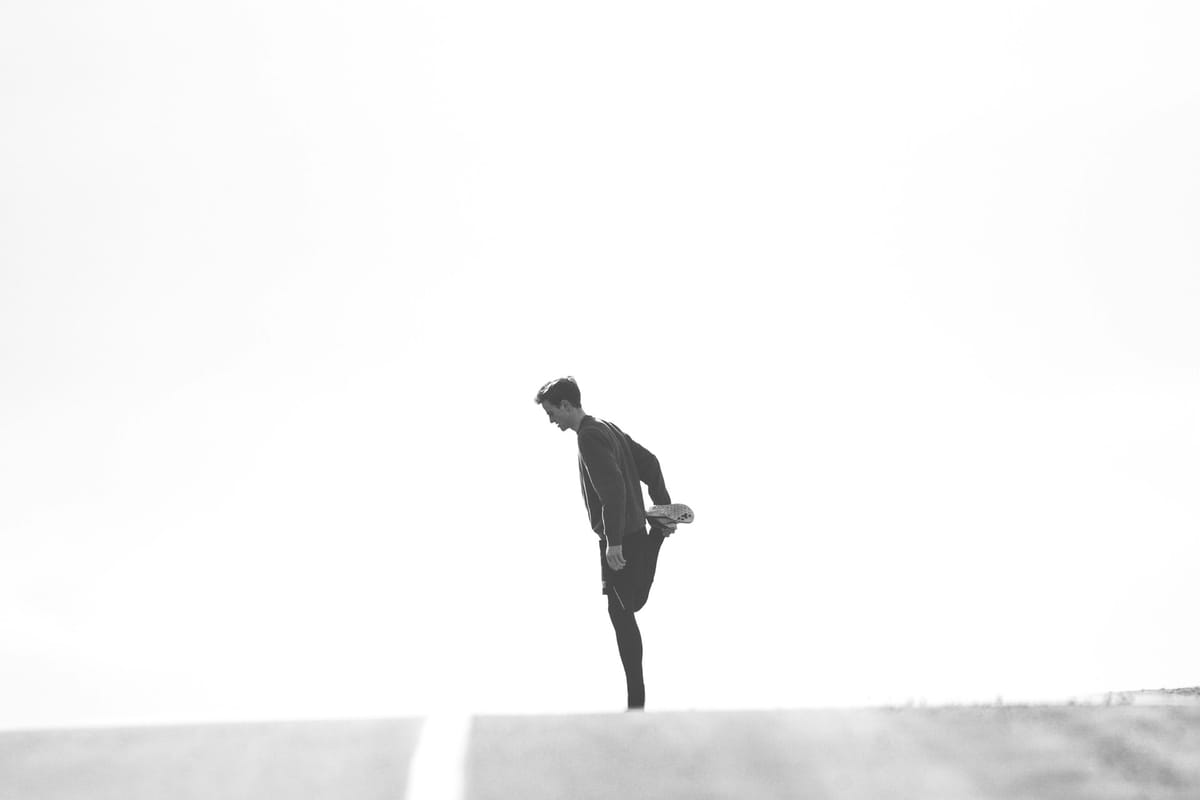Working out with injuries
If you have an injury but don't want to stop exercising completely during recovery, these tips might help.

Being injured is a setback, but it doesn't mean that all your progress is lost. In fact, active recovery can actually aid your healing, if you do it right. You shouldn't overdo it, and you need to work around the injury, to avoid making it worse. That's what we're going to explore in this article.
Here are principles to live by:
- Active recovery is better than being sedentary in a lot of situations.
- Movement that you can do without pain is more beneficial than getting stiff over time.
- If you have a clear instruction that you are not allowed to move, don't move.
- Do not work out if your organs are injured after an accident.
- Always make sure to consult your doctor and physical therapist before doing an exercise program on your own.
- A chain is only as strong as its weakest link. So don't strain the weakest link.
- When doing movements that involve the injured body part, lighter weights and higher reps are more favorable than higher weights and lower reps.
- Single limb movements are not beneficial if the other limb is injured. Working out only one side of the body can lead to muscular imbalance, which can lead to posture problems or pain later on. Also, building muscle in one leg, for example, while the other atrophies is pointless and looks weird, too. In that case, I would rather focus on other forms of movement until you can work with both legs again.
The following is a non-exhaustive list of movements you can do, sorted by the injured body part. This is just to give you an idea of how to work around an injured body part. For simplification, I centered this around joint problems. I cannot list all possible injuries here, so if your arm is broken or your left thigh is injured, different solutions apply.
Neck
Possible cardio training: Exercise bike, walking.
Possible strength training at the gym: Pushing and pulling movements with machines (but take into account tension on the neck muscles. Depending on the injury, this might not be feasible). Biceps and triceps work with machines or cable machines. Leg training with machines (Leg press, calf raises, leg extensions, leg curls).
Possible strength training without a gym: Pushing and pulling movements with resistance bands. Biceps and triceps work with resistance bands. Bodyweight squats. Calf raises.
Movements to avoid: Anything that puts too much strain on the injured body part or the surrounding muscles. In this case hanging exercises (pull-ups), barbell squats, deadlifts, shrugs, ab training and shoulder training might involve the injured area too much.
Shoulders
Possible cardio training: Exercise bike, walking, jogging, maybe elliptical machine.
Possible strength training at the gym: Pushing and pulling movements with machines (but take into account tension on the shoulder muscles. Depending on the injury, this might not be feasible). Biceps and triceps work with machines or cable machines. Ab and lower body training. Leg training with machines (Leg press, calf raises, leg extensions, leg curls).
Possible strength training without a gym: Pushing and pulling movements with resistance bands. Biceps and triceps work with resistance bands. Bodyweight squats. Calf raises.
Movements to avoid: Anything that puts too much strain on the injured body part or the surrounding muscles. In this case hanging exercises (pull-ups), dips, barbell squats, deadlifts, shrugs, ab training and shoulder training might involve the injured area too much. Regarding cardio, a rowing machine or swimming are not recommended.
Elbows
Possible cardio training: Exercise bike, walking, jogging.
Possible strength training at the gym: Pushing and pulling movements with machines (but take into account tension on the elbow. Depending on the injury, this might not be feasible). Biceps and triceps work with machines or cable machines might or might not be possible. Ab and lower body training. Leg training with machines (Leg press, calf raises, leg extensions, leg curls).
Possible strength training without a gym: Pushing and pulling movements as well as biceps and triceps work with resistance bands might or might not work. Shoulder training. Ab and lower body training. Bodyweight squats. Calf raises.
Movements to avoid: Anything that puts too much strain on the injured body part or the surrounding muscles. In this case, hanging exercises (pull-ups) and dips might involve the elbow too much. Regarding cardio, an elliptical machine, a rowing machine or swimming might cause pain.
Wrists
Possible cardio training: Exercise bike, walking, jogging, maybe elliptical machine.
Possible strength training at the gym: Possibly any movement, but keep an eye on the tension on the wrists. Keep them straight. Work with light weights. Pushing and pulling movements with machines (but take into account tension on the wrists. Depending on the injury, this might not be feasible). Biceps and triceps work with machines or cable machines. Shoulder training. Ab and lower body training. Leg training with machines (Leg press, calf raises, leg extensions, leg curls).
Possible strength training without a gym: Pushing and pulling movements with resistance bands. Biceps and triceps work with resistance bands. Shoulder training. Ab and lower body training. Bodyweight squats. Calf raises.
Movements to avoid: Anything that puts too much strain on the injured body part or the surrounding muscles. In this case hanging exercises (pull-ups), dips, heavy barbell squats, heavy deadlifts, heavy shrugs might involve the injured area too much. Regarding cardio, a rowing machine or swimming might cause problems.
Hands
This is highly depended on whether you can grip something with your hands or whether your hand is severely injured.
If you can grip something:
Possible cardio training: Exercise bike, walking, jogging, maybe elliptical machine.
Possible strength training at the gym: Possibly any movement, but keep an eye on the tension on the hands. Work with light weights. Pushing and pulling movements with machines (but take into account tension on the hands. Depending on the injury, this might not be feasible). Biceps and triceps work with machines or cable machines. Shoulder training. Ab and lower body training. Leg training with machines (Leg press, calf raises, leg extensions, leg curls).
Possible strength training without a gym: Pushing and pulling movements with resistance bands. Biceps and triceps work with resistance bands. Shoulder training. Ab and lower body training. Bodyweight squats. Calf raises.
Movements to avoid: Anything that puts too much strain on the injured body part or the surrounding muscles. In this case hanging exercises (pull-ups), dips, heavy barbell squats, heavy deadlifts, heavy shrugs might involve the injured area too much. Regarding cardio, a rowing machine or swimming might cause problems.
If you cannot grip something:
Possible cardio training: Exercise bike, walking, jogging
Possible strength training at the gym: Butterfly and reverse butterfly machine if it has a cushion for the arms, and doesn't require you to grab the handle. Ab and lower body training. Leg training with machines (Leg press, calf raises, leg extensions, leg curls).
Possible strength training without a gym: Ab and lower body training. Bodyweight squats. Calf raises.
Movements to avoid: Anything that puts too much strain on the injured body part or the surrounding muscles. In this case hanging exercises (pull-ups), dips, heavy barbell squats, heavy deadlifts, heavy shrugs might involve the injured area too much. Regarding cardio, a rowing machine or swimming might cause problems.
Back
Possible cardio training: Exercise bike, walking, jogging, maybe elliptical machine.
Possible strength training at the gym: Possibly any movement, but keep an eye on the tension on the back. Work with light weights. Pushing and pulling movements with machines (but take into account tension on the back. Depending on the injury, this might not be feasible). Biceps and triceps work with machines or cable machines. Shoulder training. Ab and lower body training might or might not be a good idea, depending on the back injury. The same goes for leg training with machines (Leg press, calf raises, leg extensions, leg curls). Depending on the injury, leg press might not be feasible because it involves the lower back.
Possible strength training without a gym: Pushing and pulling movements with resistance bands. Biceps and triceps work with resistance bands. Shoulder training. Ab and lower body training might or might not be a good idea, depending on the back injury. The same goes for leg training (Squats, calf raises). Depending on the injury, squats might not be feasible because it involves the lower back.
Movements to avoid: Hip hinging movements or movements that make you bend over. Anything that puts too much strain on the injured body part or the surrounding muscles. In this case hanging exercises (pull-ups), dips, heavy rows, heavy barbell squats, heavy deadlifts, heavy shrugs might involve the injured area too much. Regarding cardio, a rowing machine or swimming might cause problems.
Hips
Possible cardio training: Exercise bike, walking.
Possible strength training at the gym: Pushing and pulling movements with machines (but take into account tension on the hips). Biceps and triceps work with machines or cable machines. Shoulder training. Leg training with machines (calf raises, leg extensions, leg curls). Depending on the injury, leg press might not be feasible.
Possible strength training without a gym: Pushing and pulling movements with resistance bands. Biceps and triceps work with resistance bands. Shoulder training. Ab and lower body training might or might not be a good idea, depending on the hip injury. The same goes for leg training (Squats, calf raises). Depending on the injury, squats might not be feasible.
Movements to avoid: Hip hinging movements or movements that make you bend over. Anything that puts too much strain on the injured body part or the surrounding muscles. In this case, heavy rows, heavy barbell squats, heavy deadlifts, might involve the injured area too much. Ab and lower body training might not be a good idea, depending on the injury. Regarding cardio, a rowing machine or swimming might cause problems.
Knees
Possible cardio training: Exercise bike, walking, swimming (if you only use your upper body).
Possible strength training at the gym: Pushing and pulling movements with machines. Biceps and triceps work with machines or cable machines. Shoulder training. Depending on the injury, leg training might not be feasible.
Possible strength training without a gym: Pushing and pulling movements with resistance bands or bodyweight. Biceps and triceps work with resistance bands. Shoulder training. Ab training. Calf raises. Depending on the injury, squats might not be feasible.
Movements to avoid: Anything that puts too much strain on the injured body part or the surrounding muscles. In this case, (barbell) squats and deadlifts might involve the injured area too much. Regarding cardio, a rowing machine or anything that has high impact on the knee, such as jogging, should be avoided.
Ankles/Achilles' heels
Possible cardio training: Exercise bike, walking, swimming.
Possible strength training at the gym: Pushing and pulling movements (with or without machines). Biceps and triceps work. Shoulder training. Depending on the injury, leg training might or might not be feasible.
Possible strength training without a gym: Pushing and pulling movements with resistance bands or bodyweight. Biceps and triceps work with resistance bands. Shoulder training. Ab training. Depending on the injury, Bodyweight Squats might work well, but not calf raises.
Movements to avoid: Anything that puts too much strain on the injured body part or the surrounding muscles. In this case, (barbell) squats and deadlifts might or might not involve the injured area too much. Regarding cardio, anything that has high impact on the ankle, such as jogging, should be avoided.
Feet
This is highly depended on whether you can tread or whether your foot is broken, for example, and in a plaster cast.
Possible cardio training: Walking with crutches, maybe exercise bike, driving with a wheelchair (by yourself - it's a great arm workout).
Possible strength training at the gym: Pushing and pulling movements (with or without machines). Biceps and triceps work. Shoulder training. Depending on the injury, leg training might or might not be feasible.
Possible strength training without a gym: Pushing and pulling movements with resistance bands or bodyweight. Biceps and triceps work with resistance bands. Shoulder training. Ab training. Depending on the injury, Bodyweight Squats might work well, but not calf raises.
Movements to avoid: Anything that puts too much strain on the injured body part or the surrounding muscles. In this case, (barbell) squats and deadlifts might or might not involve the injured area too much. Regarding cardio, anything that has high impact on the feet such as jogging should be avoided.
Which equipment is suitable for exercising with injuries?
Resistance bands
Resistance bands let you perform a movement independent of gravity, which can be a huge advantage when it comes to training for recovery. Free weights don't offer this flexibility, as they are pulled by gravity. This can make some movements unsafe or too complex or difficult when you are injured. With resistance bands, you can pick the resistance that best suits your current situation and work with either full range or limited range of motion, while still being able to move safely.
Machines
Machines don't offer the same flexibility as resistance bands, but they offer a safety net because the motion is predefined. Without needing to focus too much on stabilizing the movement, you can just perform the exercise and provide your muscles the stimulation of working against a resistance.
Cable machines
Cable machines have the same benefits as resistance bands, as you can really customize the movements to your ability. The added benefit is that it is easier to progress because you can easily stack more weight on top, while still working around the injury. With resistance bands, progressive overload is not impossible, but less intuitive.
Cardio machines
Cardio machines sometimes get a bad reputation, but undeservedly so. When you have a broken arm or another injury that doesn't allow you to safely participate in traffic or move outside in general, a cardio machine can be a great way to train your cardiovascular health. If you can't walk, a rowing machine or SkiErg lets you use your upper body to get a good cardio workout in.
Walk if you can
If I had to pick only one exercise that I could do (if the injury allows it), I would pick walking. Walking is so underrated in terms of health benefits. It has a very low impact on the joints, lets you move outside, improves your cardiovascular health and can (in most cases) be done for long periods of time. Walking in nature not only has physical health benefits, but also improves mental health and stress levels. When done with friends and family, it can also serve as a shared activity that improves your relationships and creates social connections.
Examples from my own experience
When my hand was injured from an accident and I had a plaster cast, I worked my upper body on a butterfly and reverse butterfly machine. I added leg press and calve raises and did cardio on a stationary bike as well as light jogging.
When I had a tennis elbow from doing too many pull-ups with weight over months, I switched to doing pullovers and rows, no pull-ups. The rest of my exercise regimen stayed the same.
When I had a rotator cuff injury from wrestling, I couldn't do any overhead movements. What I could do were push and pull exercises with bands and machines, biceps and triceps exercises, and leg exercises with machines. Barbell squats were not possible, as my shoulder would hurt when I held the bar. My cardio training wasn't affected.
When I had a knee injury from judo, I could still do my normal upper body workouts. Leg training was cancelled for the time being, but walking was doable without pain, so I walked a lot.
When my Achilles' heel hurt from too much trail running, I could still do my upper body workouts for strength. Squats also didn't cause pain. For cardio, I switched to cycling instead of running/jogging. I also did light walking, swimming and HIIT cardio with focus on squatting and dynamic upper body movements such as shadow-boxing or push-pull movements with a stick.
Disclaimer
This site cannot and does not contain medical/health advice. The medical/health information is provided for general informational and educational purposes only and is not a substitute for professional advice. Accordingly, before taking any actions based upon such information, we encourage you to consult with the appropriate professionals. We do not provide any kind of medical/health advice. The use or reliance of any information contained on the site is solely at your own risk.



